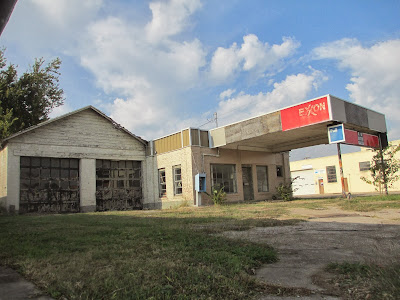When you drive down the road, other than dirt, gravel, concrete or macadam, what do you see; usually, a McDonalds, Holiday Inn and a Mobil. One aspect of the road travelers tend to remember are the various roadside businesses and attractions they pass along the way. There are various kinds of edifices or objects that add to a traveler’s journey. One of these highway magnets is the gas station.
Today, we may not think of the multitude of Exxon’s and Valero’s as nothing more than food for our vehicles. Nevertheless, due to the popularity of blue highways such as Route 66, the gas station has become an icon in the American roadside. These stations represent what the traveling experience was and continues to be about; feeding the gas guzzler at the Shamrock station in Newkirk, New Mexico, grabbing a piece of pie at Kelly’s Café in Wickenburg, Arizona, and then off to Disney Land or some unknown destination.
John A. Jakle argues how children and adults of different generations were affected by the automobile. He believes that childhood memories of the roadside created a “strong emotional charge” that they would carry with them to adulthood. For instance, roadside attractions such as the gas station provide nostalgic memories for those of older generations. According to Jessi, a highway enthusiast, “When I drive by, or pull into, look around, touch, etc, old service stations, motels, businesses, I feel a flutter in my gut, and a quiet sadness. I remember the yesterdays, where I was or my parents, etc., how people looked and acted, differences and likeness of now, and what they drank and ate, all those details that are so vivid and make history and life come alive. To me connecting with the past, especially everyday life is incredibly fulfilling.” This feeling of nostalgia helped create the modern day traveling experience as older blue highways like Route 66 have not only become tourist destinations, but a place for those to seek the “good old days.”
According to Jakle and Keith A. Sculle, “in the case of gasoline stations, associations are engendered around our caring for the automobile, that indispensible amplifier of human mobility.” In other words, without the gas station, we would not be able to use our automobile to fulfill our journey. The stations were also a place for men to not only share mechanical utterances, but information in their personal lives.
For travelers, however, passing a gas station was an amusing and exciting experience. This is aided by the fact that gas stations, like other roadside businesses, are place-products (name brands) that are easily identified by travelers. As the automobile and highways proliferated, gas stations grew and became integral parts of the road in the United States. The exploration of America coincided with this spread of corporate sponsored gas stations. People who traveled on Route 66 or the Lincoln Highway, for instance, would be able to tell you about that Sinclair Station in Gay Parita, Missouri or old Texaco filling station in Orrville, Ohio. For travelers such as Jakle and Jim Hinkley, driving past gas stations was a unique event in and of itself. For Jakle, as he rode down the highway growing up, “His [Jakle] impulse was to count things and as he got older what he counted most were gasoline stations for they stood out by the roadside with the colorful signs and insignia and distinctive design.” Moreover, Jakle was “amused” by the fact that as he traveled to different regions of the nation he noticed how the gas station brands differed. “Special trips in the 1950’s were made by car to New York (Socony), New England (Esso)… and west to Wyoming (Sinclair) and Colorado (Conoco).” In the case of Mr. Brinkley, it was “the bell, the unmistakable aroma of rubber, gas, grease, old cigarette smoke, and hot engines tempered with the smell of fresh cut grass on a hot summer evening, the ice cold bottle of pop after a long drive across the desert.” Although many of the Magnolia, Exxon or Sinclair stations are inoperable today, they remain a link to our highway heritage.



No comments:
Post a Comment